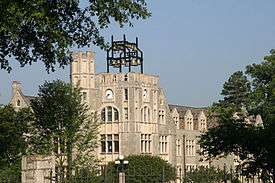Thomas Kimmwood Peters
Thomas Kimmwood Peters (June 27, 1879 – 1973) was a pioneer American motion picture producer, newsreel cameraman, photographer, educator, and inventor.[1][2][3][4][5][6]
Thomas Kimmwood Peters | |
|---|---|
 | |
| Born | June 27, 1879 [1] Norfolk, Virginia, USA |
| Died | 1973 [1] California, USA |
| Occupation | newsreel cameraman, photographer, and inventor [1] |
| Known for | early motion picture development |
| Spouse(s) | Grace Margaret Price [1] |
| Parent(s) | William Isbestos Peters Laura Virginia (Logan) |
Education
Association with the motion picture industry
Peters began his photography work in the motion picture industry around 1899,[6][7] with the Pathe Freres film company of France.[6][7] Later, when he left them, he continued to work throughout Europe at various companies in the motion picture industry to develop his skills.[6][7] He also did photography and motion picture work at Karnak and Luxor in Egypt.[3][6]
Peters was associated with the Cosmos Film Company in San Francisco, California, which later became Exactus Photo Film Corporation of Palo Alto.[6][7] He became its first president and general manager when it officially started operations on August 28, 1914.[7] The company stated that its purpose was
to produce, sell, rent and exchange educational and industrial moving picture films for the use of schools, academies, and universities throughout the state of California, and later throughout the United States.[7]
In the beginning, Exactus had a list of well-respected California educators to serve on its board of directors.[7] However, a lack of good business management and closing skills in obtaining financial backing caused its failure only two years later.[7] There were also clashes of misunderstandings between the educators and Exactus' technicians that exacerbated the situation.[7] By the end of 1916, Peters held an auction of the physical items held by the bankrupt company to raise money to pay off its creditors.[7] What little stock left was turned over to the Palo Alto Film Company.[7]
Peters kept the technical and educational value of the Exactus films at a high quality in spite of these tumultuous times.[7] At the Panama-Pacific International Exposition in 1915, his company won two gold medals and one bronze medal for films they had produced.[7]
Association with Oglethorpe University

Thornwell Jacobs, originator of the Crypt of Civilization (the world's first modern time capsule located at Oglethorpe University), hired Peters to serve as the project archivist and general manager of development and construction.[1][2][5][6]
One of the reasons Peters was hired was for his unique skills in photography.[2] He used his knowledge to preserve on microfilm and film footage items to be entered in the Crypt for a 6,000-year storage.[2][6] Peters recorded on film such historical figures as Adolf Hitler and Joseph Stalin. He also included President Franklin D. Roosevelt and Benito Mussolini.[2]
Peters and his staff of student assistants worked on the Crypt project from 1937 until 1940 when it was sealed permanently.[2][6] They put on cellulose acetate microfilm many historical events of the 19th and 20th centuries.[2] The microfilm reels were placed into airtight receptacles for preservation.[2] The staff and Peters initiated backup methods in case the acetate didn't survive.[2] One method Peters developed was duplicate "metal film."[2] It was as thin as paper.[2]
Peters also worked on developing Oglethorpe University's historical photographic collections.[4][6] Peters was also director of the China Air Force School at Oglethorpe University, 1945-46.[1][6] He was also professor of audio-visual education at the university.[1]
According to Oglethorpe University Peters had been the only newsreel photographer to film the San Francisco earthquake of 1906 and the associated fire. He was also the first to film the construction of the Panama Canal.[3][4][5][6]
Outline of career
- Artist with International Botanical Expedition to Yucatán, 1898.[1][6]
- Cameraman with Pathe Freres, Vincennes, France, 1899.[1][6]
- Toured Europe and Northe Africa making motion pictures with a Kinetoscope, 1900.[1][6]
- Freelanced in Paris, 1902.[1][6]
- Opened Peters Scenic Studio in Los Angeles, 1902.[6]
- President of Peters Photographic Expeditions. Made 5 expeditions to Asian countries, Australia and the South Seas, 1904-05.[1][6]
- Motion pictures of San Francisco earthquake aftermath, 1906.[3][4][6]
- Motion pictures of construction of the Panama Canal, 1909.[1][3][4][6]
- Technical director of several motion picture companies.[6]
- Author and correlator of standard text films for classroom use at Palo Alto and F.B.O. Studio, Hollywood.[6]
- Inaugurated first regulator teaching films in New York Schools, 1920.[1][6]
- Professor of psychology training specialist and manufacturing research engineer at Lockheed Aircraft Company.[6]
- Historian at the Los Angeles County Hollywood Museum Motion Picture TV.[6]
- Owner of Photographic Museum, Frontier Village, San Jose, California.[6]
Authored works
Inventions
References
- "Thomas Kimmwood Peters papers, 1896-1973 (bulk 1915-1968)". Retrieved 21 February 2011.
- "The New Georgia Encyclopedia - Crypt of Civilization". Retrieved 2008-07-06.
- "Oglethorpe University - History of the Crypt of Civilization". Archived from the original on 2008-05-09. Retrieved 2008-07-06.
- "University of California, OAC - Finding Aid for the Thomas Kimmwood Peters Papers, 1935-1964". Retrieved 2008-07-06.
- "The New Georgia Encyclopedia - T. K. Peters". Retrieved 2008-07-06.
- Who's Who in America
- "Stanford University Libraries - Guide to the Exactus Photo Film Corporation Records, 1914-1918". Retrieved 2008-07-08.
- "The Crypt of Civilization written by Alan Bellows October 9th, 2006". Retrieved 2008-07-06.
Bibliography
- Peters, Thomas Kimmwood, The Story of the Crypt of Civilization, (Oglethorpe University Press, Atlanta, 1940).
- Slide, Anthony, The New Historical Dictionary of the American Film Industry, Fitzroy Dearborn 1998, ISBN 1-57958-056-4
- The Preservation of History in the Crypt of Civilization, journal of Society of Motion Picture Engineers (February 1940), pp. 209–10.
- Who's Who in America With World Notables (Chicago, 1978), subject of item # 1712 - "Thomas Kimmwood Peters", Library of Congress Card No. 43-3789, ISBN 0-8379-0210-X
- Library of Congress, ID No: MSS61200
- Papers of Thomas Kimmwood Peters
- Span Dates: 1896-1973 (bulk 1915-1968)
- Creator: Peters, Thomas Kimmwood, 1879-1973
- Repository: Manuscript Division, Library of Congress, Washington, D.C.